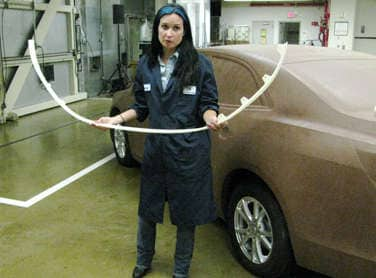Recent Articles
Popular Makes
Body Types
Extensive Aero Work Hits Bull’s-eye with 2013 Chevy Malibu
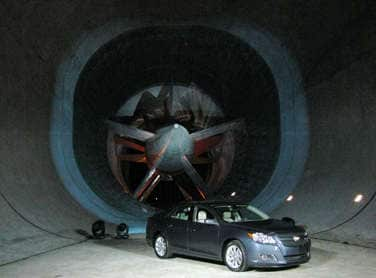
When Chevrolet first started work on the all-new Chevrolet Malibu, it quickly became clear that to reach the goal of creating the division’s most fuel-efficient, most aerodynamic midsize sedan ever, it would require all teams to pull together and work as one—but they did and it is.
Thanks to a comprehensive effort across all areas of the vehicle-development process, the 2013 Malibu boasts a coefficient of drag of just .29, which is similar to the mark put up by the sleek Chevy Corvette and only slightly higher than the high-efficiency Chevy Volt. Note as well that the Malibu's coefficient of drag isn’t merely some number pulled out of a hat; it was determined using the new testing regimen recommended by the Society of Automotive Engineers (SAE), the same group that helped develop industry-wide standards for reporting horsepower.
The bottom line: The Malibu ECO’s slippery exterior, combined with its innovative eAssist light-electrification system, is expected to raise the EPA bar to 26 mpg city/38 mpg highway.
“With the new Malibu, the design and aero teams collaborated to achieve maximum fuel efficiency for our customers without compromising the car’s visual appeal,” said John Cafaro, Chevrolet Malibu exterior design director. “The aero and aesthetic evolved simultaneously—working together we sculpted the car in a way that makes it more slippery, applied innovative technologies like eAssist and active shutters, and we intentionally designed components such as the rear deck lid and outside rearview mirrors to help maximize fuel economy.”
But how exactly did the Malibu become such a smooth operator? As noted American philosopher Bob Dylan once put it, “The answer my friend, is blowin’ in the wind.” Only in this case, the breeze is supplied by GM’s massive wind tunnel, located at its Technical Center in Warren, Mich.
There, at the largest closed-loop wind tunnel in the world dedicated to automotive testing, a 4,500-hp variable-speed DC motor spins giant custom-made wooden fan blades at speeds of up to 270 rpm to produce wind speeds in excess of 135 mph. The Malibu team spent more than 400 hours in the wind tunnel to fine tune the car’s aerodynamics, and the outcome was fine indeed.
Pictured: John Cafaro, Chevrolet Malibu exterior design director, points out the highly aerodynamic rounded corners of Chevy’s new midsize sedan.
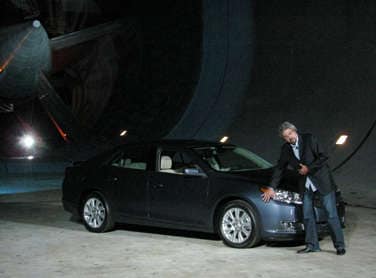
Among the aero enhancements to the Malibu was the addition of underbody panels—similar to those used on some of the world’s fastest supercars and racecars—that address the significant drag that can be created by components causing air turbulence beneath the car. In fact, the Malibu ECO actually has four different underbody panels, two in the mid-body area and two at the rear of the car, covering approximately half of the overall underbody area.
Wind-tunnel work also helped Chevrolet Malibu designers reduce drag in a number of other ways, including:
• The front “corners” of the car were given a rounded shape that allows air to flow more smoothly along the vehicle’s sides.
• Specially designed deflectors are employed ahead of the front tires and function like miniature air dams to minimize wind disruptions.
• A full-size front air dam and integrated decklid spoiler further optimize airflow over the vehicle.
• Even small things, like the shape of the outside mirrors, as well the angle created by the top of the rear glass and the trailing edge of the decklid, have been carefully engineered for aerodynamic benefits.
Pictured: John Bednarchik, the lead aerodynamic engineer for the all-new Malibu, explains the aero benefits of the car’s decklid.
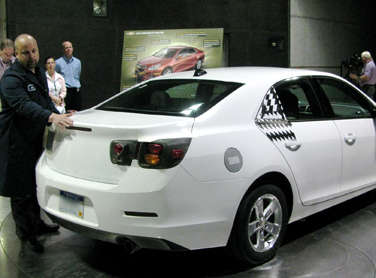
But Malibu engineers weren’t satisfied with passive measures such as these, which is why the Malibu LT and ECO models are the first to introduce active aerodynamic enhancers to Chevrolet’s midsize sedan family. Like certain other vehicles—including the Chevrolet Cruze ECO—the new Malibu will offer movable grille shutters that can open during low speeds for maximum engine cooling and then close for improved aerodynamics as the car goes faster. But instead of activating solely based on how fast the vehicle is going, as is the case with systems from rival automakers, the grille shutters in the Malibu are controlled by a proprietary GM algorithm that takes into account factors like engine load, vehicle speed and ambient temperature, in real time, to better optimize performance.
For example, when temperatures outside drop below freezing and an engine needs to warm up quickly to operate efficiently, the Malibu’s active grille shutters go into “ice mode.” This keeps them from opening until onboard sensors indicate the ambient temperature has climbed above the 32-degree point.
Pictured: Note how closely the smoke sticks to the Malibu’s rear glass, an indication of its low coefficient of drag of .29.
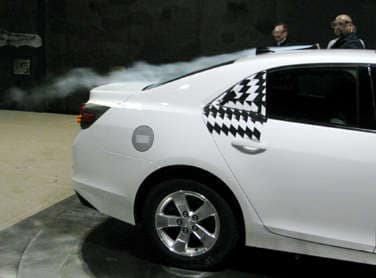
All this attention to detail doesn’t come easy, though, and it doesn’t always come quickly, either. Creating a new part or modifying a current one in the name of improving aerodynamics can take plenty of time and money—unless you have the kind of cutting-edge fabrication technology in use at GM’s Tech Center.
Thus, the company’s 3D Rapid Prototyping Lab played an integral part in the Malibu’s development, leveraging selective laser sintering (SLS) and stereo lithography (SLA) to quickly create body parts and components to assist with wind-tunnel testing. By relying on these resources, parts that used to take weeks to make can now be created in days, and without the need to develop expensive tooling to make them. That’s because SLS and SLA use computer software and specialized equipment to automatically sculpt the parts out of a plastic-like, liquid material. Although these parts generally aren’t suitable for use on production vehicles, they are ideal for quick changes in the wind tunnel.
“Every Malibu model we worked with had some sort of rapid prototype part on it,” said Suzanne Cody, the Malibu’s aerodynamic development engineer. “We tested and retested the Malibu’s outside rear view mirrors, air dams and other parts to ensure we got the most aerodynamic efficiencies out of the part, which translates to fuel economy for our customers. Rapid prototyping allowed us to quickly make millimeter changes to a part and cut our development time significantly.”
All of which means that when it comes to getting the message out about the new Malibu’s aerodynamics and fuel-efficiency, you can be sure Chevrolet engineers are doing much more than just blowing smoke—although yes, they still do that, too.
Pictured: Suzanne Cody, the Malibu’s aerodynamic development engineer, shows off a rapidly prototyped Malibu air dam.
